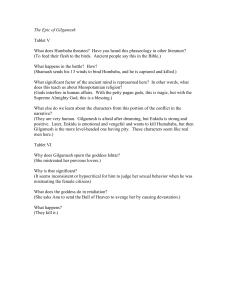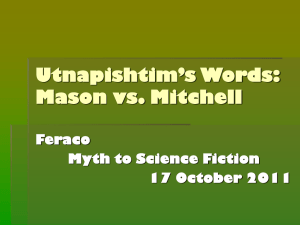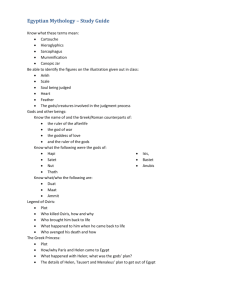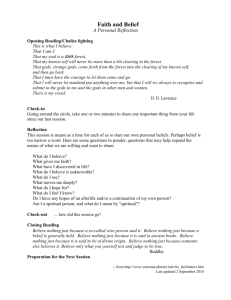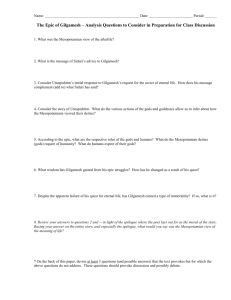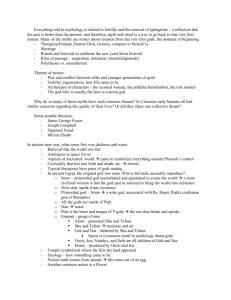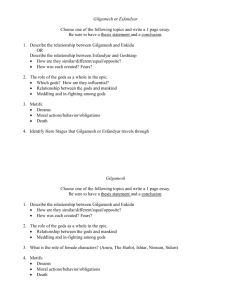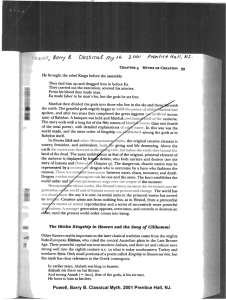Model of Part of an Interdisciplinary Test
advertisement
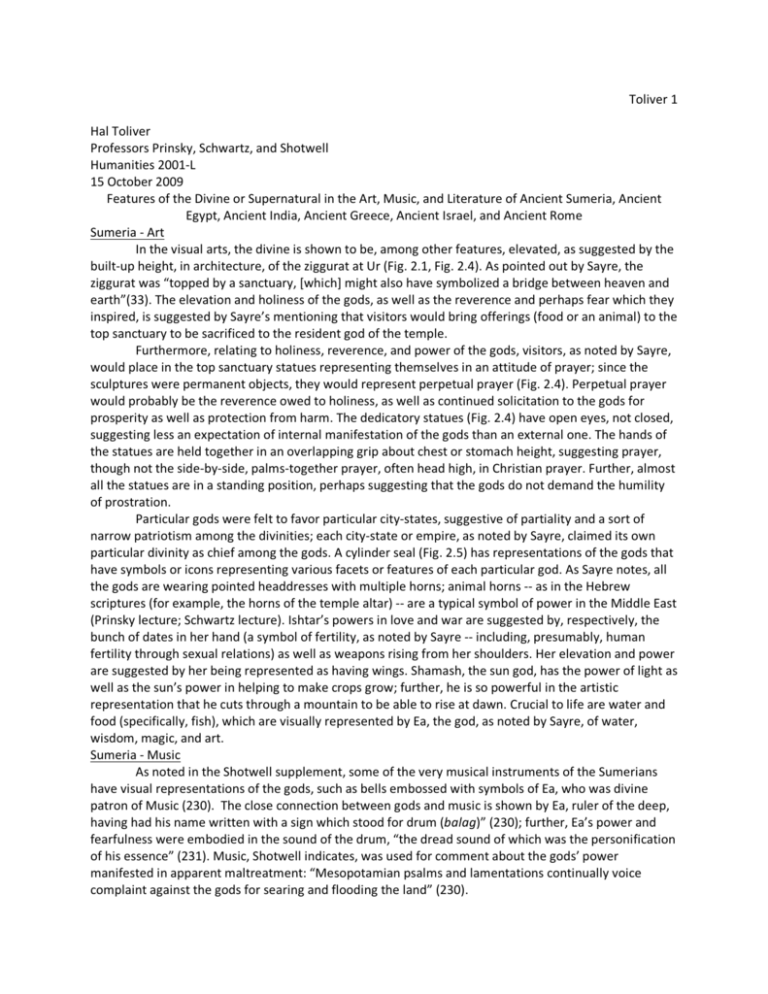
Toliver 1 Hal Toliver Professors Prinsky, Schwartz, and Shotwell Humanities 2001-L 15 October 2009 Features of the Divine or Supernatural in the Art, Music, and Literature of Ancient Sumeria, Ancient Egypt, Ancient India, Ancient Greece, Ancient Israel, and Ancient Rome Sumeria - Art In the visual arts, the divine is shown to be, among other features, elevated, as suggested by the built-up height, in architecture, of the ziggurat at Ur (Fig. 2.1, Fig. 2.4). As pointed out by Sayre, the ziggurat was “topped by a sanctuary, [which] might also have symbolized a bridge between heaven and earth”(33). The elevation and holiness of the gods, as well as the reverence and perhaps fear which they inspired, is suggested by Sayre’s mentioning that visitors would bring offerings (food or an animal) to the top sanctuary to be sacrificed to the resident god of the temple. Furthermore, relating to holiness, reverence, and power of the gods, visitors, as noted by Sayre, would place in the top sanctuary statues representing themselves in an attitude of prayer; since the sculptures were permanent objects, they would represent perpetual prayer (Fig. 2.4). Perpetual prayer would probably be the reverence owed to holiness, as well as continued solicitation to the gods for prosperity as well as protection from harm. The dedicatory statues (Fig. 2.4) have open eyes, not closed, suggesting less an expectation of internal manifestation of the gods than an external one. The hands of the statues are held together in an overlapping grip about chest or stomach height, suggesting prayer, though not the side-by-side, palms-together prayer, often head high, in Christian prayer. Further, almost all the statues are in a standing position, perhaps suggesting that the gods do not demand the humility of prostration. Particular gods were felt to favor particular city-states, suggestive of partiality and a sort of narrow patriotism among the divinities; each city-state or empire, as noted by Sayre, claimed its own particular divinity as chief among the gods. A cylinder seal (Fig. 2.5) has representations of the gods that have symbols or icons representing various facets or features of each particular god. As Sayre notes, all the gods are wearing pointed headdresses with multiple horns; animal horns -- as in the Hebrew scriptures (for example, the horns of the temple altar) -- are a typical symbol of power in the Middle East (Prinsky lecture; Schwartz lecture). Ishtar’s powers in love and war are suggested by, respectively, the bunch of dates in her hand (a symbol of fertility, as noted by Sayre -- including, presumably, human fertility through sexual relations) as well as weapons rising from her shoulders. Her elevation and power are suggested by her being represented as having wings. Shamash, the sun god, has the power of light as well as the sun’s power in helping to make crops grow; further, he is so powerful in the artistic representation that he cuts through a mountain to be able to rise at dawn. Crucial to life are water and food (specifically, fish), which are visually represented by Ea, the god, as noted by Sayre, of water, wisdom, magic, and art. Sumeria - Music As noted in the Shotwell supplement, some of the very musical instruments of the Sumerians have visual representations of the gods, such as bells embossed with symbols of Ea, who was divine patron of Music (230). The close connection between gods and music is shown by Ea, ruler of the deep, having had his name written with a sign which stood for drum (balag)” (230); further, Ea’s power and fearfulness were embodied in the sound of the drum, “the dread sound of which was the personification of his essence” (231). Music, Shotwell indicates, was used for comment about the gods’ power manifested in apparent maltreatment: “Mesopotamian psalms and lamentations continually voice complaint against the gods for searing and flooding the land” (230). Toliver 2 The power of the gods, and the reverence required, are shown in “liturgists,” whose duty was “to intone the liturgic cantillation” of sacred texts, being one of the groups to be found in the Sumerian temple (231). Likewise, musicians were part of the standard musical elements of the temple (232). Music being devoted to the divine, the gods, is suggested by the “vast treasures . . . of liturgies, breviaries, psalms, and songs” that were connected to the temple (233). Some psalms show worshipers praying for the gods’ power to rescue from difficulty, such as the reference to “A song to the tune ‘Thou wilt not cast me down’” (234). Apparently, the gods were felt to require a rigidity or order in prayer; as noted by Shotwell, “the liturgy demanded a fixed and immutable chant, any variation from which by precentor or chorister would be unthinkable, since its whole efficacy depended on rigid interpretation” (235). The gods themselves were felt to be expert in music, and thus would immediately perceive any mistake; as noted by Shotwell, human skill and freedom from mistakes were “an absolute desideratum, since the gods were equally skilled [in music], as we know from the epithet of the goddess Ishtar, the patroness of litanies, as the one ‘who understands the measures’ of the psalming” (235). This expertise clearly suggests that the gods enjoyed or appreciated music. Sumeria - Literature As implied by NAWL editors Knox and Clinton, in their introduction to the epic Gilgamesh the gods have some sense of modifying the bad behavior of the half-human, half-god Gilgamesh, since Enkidu comes to Uruk for “the confrontation with Gilgamesh for which the gods have created him” (11). The gods may prove helpful to mortals, as shown by Enkidu and Gilgamesh defeating “the terrible giant Humbaba . . . . with the blessing of the sun god” (11). Knox and Clinton’s remark that “Enlil, the god of wind and storm, is enraged by the slaying of his creature” (11) shows that the gods can be vindictive as well as helpful; this vindictiveness is further suggested by how Enlil “curses the heroes and gives to others” what had been possessions of Humbaba but will not become the possession of the mortal victors over him. Knox and Clinton sum up that a key component of epic is the exploration of “the complex and perilous relations between gods and mortals” (11). The power of the gods, as well as their interest in human beings (or at least in some human beings) is suggested by how the goddess Aruru has created the human race (I.90-95), as well as, particularly, Enkidu (I.99-107); further, the Lady of Birth and the God of Wisdom contribute to the making of Gilgamesh (I.51-52). The text states that Anu, Enlil, and Ea have “broadened his [Gilgamesh’s] wisdom” (I.242). When Humbaba says to Gilgamesh that Gilgamesh grew up to fulfill the oracle of Shamash (V.66), the gods’ involvement in human destiny is suggested, as well as the fostering of some particular human beings. The gods at times seem compassionate, offering help to human beings. Because of the erratic behavior of Gilgamesh after the death of Enkidu, “Shamash was disressed” (IX.22). Shamash helps Gilgamesh and Enkidu in their fight with Humbaba by raising paralyzing winds (V.56-62). Some goddesses are receptive to complaints or prayers from women -- as in relation to Gilgamesh’s seigneurial rite of displacing the bride’s husband on the wedding night (I.74-75) -- as is the goddess Anu (I.88-89). The god Ea discloses the secret of the impending worldwide flood to human being Utanapishtim in order to save him, as well as what to tell other human beings about the building of an ark (XI.20-47). Sometimes the gods’ actions are inexplicable and dictatorial, as in the creation by Enlil (Lord of the Air) of the supernatural monster Humbaba to “safeguard the forest of cedars” (II.165, II.177, II.253, II.270) and “terrify the people” (II.166, II.178, II.254, II.271) and even show superiority to some of the other gods (II.176, II.252, II.269). Also suggestive of a hierarchy among the gods is that some deities are subordinate guardian ones who may lead a worshiper to a greater god (II.22, and footnote 3). In the Toliver 3 story told by Utanapishtim (the Sumerian Noah), the gods simply “resolved to send the deluge” to destroy all human beings and living creatures, with no explanation (XI.11-14). The awesome power of the gods is repeatedly evident in the imagery of how they destroy the world with the flood and its components (including fire and lightning) (XI.100-115). The gods can show specific human emotional or psychological traits. For example, they sometimes seem susceptible to a kind of bribery, as when Gilgamesh offers “various blandishments to Shamash, god of oracles” to get a more favorable prophecy for Gilgamesh’s enterprise (III.113-128). The delights for and of human beings can sometimes affect the gods, such as when the text states that “even the great (gods) are kept from sleeping at night!” by the city of Uruk’s pleasures (I.232). Ishtar, goddess of love and sex, shows a human lustfulness when she is attracted to Gilgamesh and proposes marriage, offering majesty and wealth (VI.6-21). When Gilgamesh gives a detailed outline of the several past romantic loves and betrayals of Ishtar (VI.22-79), she shows the human traits of wounded pride, fury, and vengefulness in her reaction to Gilgamesh’s rejection (VI.80-115). Further, the gods can manifest fear, when as the flood reaches a climax “the gods became frightened of the deluge,” they “shrink back” and “cowered like dogs” up in Anu’s highest heaven (XI.116-118). Perhaps most important among the facets of the gods and goddesses is their immortality, their exemption from death. Utanapishtim tells Gilgamesh that the striving of a mortal for immortality is futile, and that only “the supreme gods” have “established death and life” for mortals (X.297-321). Thus, even though Shamhat says to Enkidu “you are become like a god” (I.207, II.6), the gods decree and implement Enkidu’s death (Tablet VII). And although Gilgamesh has almost divine power -- “like the force of heaven, so mighty is his strength” (I.137) -- the death of Enkidu shakes him and causes worry about his own mortality and death (X.46-75, X.153-81, X.239-67), to which he appears tearfully resigned at the end of the epic, though remaining proud of the building arts exemplified by the city of Uruk (XI.312-333). Egypt - Art As shown by Sayre, the Palette of Narmer (“Closer Look,” p. 70) shows that the king being barefoot suggests that he is on sacred ground “and that his acts are themselves sacred.” The Palette also prominently displays the hawk, the god Horus, who “the king was regarded as the earthly embodiment of.” The burial of the dead on the west side of the Nile suggests “a symbolic reference to death and rebirth, since the sun always rises again” (p. 72). The pyramids were “the symbolic embodiment of his [the king’s] eternal life” since they “would endure for generations as, Egyptians believed, would the king’s ka” or “enduring ‘soul’ or ‘life force’” (p. 72). Bodies in the pyramid had to be preserved so that the “personality, or ba” would be recognized by the ka for eternity (p. 73). The Great Sphinx, by combining “animal and human forms . . . suggests the king’s connection to the gods” (p. 76). Funerary sculpture “served the same purpose as the pyramids . . . to preserve and guarantee the king’s existence after death, thereby providing a kind of rebirth” (p. 76). In the Seated Statue of Khafre from the valley temple of Khafre, Giza (fig. 3.9), can be found “a hawk, a manifestation of the god Horus, extending its wings in a protective gesture” (p. 76), suggesting the protective aspect of the supernatural for the king; also, since the hawk seems “as if caressing” the king’s head (p. 77), a further suggestion is the love or affection of the supernatural or divinity for the king. As noted by Sayre, the divinity in the statue is “shown” by “a perfectly smooth, proportioned face and a flawless, wellmuscled body”; this “perfection” helped in “mirroring the perfection of the gods themselves” (p. 77). The statue of Menkaure with a Queen (fig. 3.10) shares with the Statue of Khafre “solidity and unity” and a “sense of resolute purpose” which “testifies finally to” the “purpose, which is to endure for eternity” (p. 77). The importance of female gods is shown in the inclusion of Mut, the wife of the god Amun, as a Toliver 4 focus of worship in the Great Temple of Amun at Karnak (p. 82). The devotion of the people to the gods was shown by priests’ daily activity, who “washed the deity statue, clothed it with a clean garment, and offered it two meals of delicious food” (p. 83). Exclusivity in worshiping the gods is indicated by the fact that “only kings and priests were admitted to the sanctuary,” though some broadening of the worship occurred “at festival times” when “the cult statue of the deity was removed to lead processions” (p. 83). The relief Akhenaten and His Family (fig. 3.22), in the prominence given to the sun, whose rays spread to the king, queen, and the children of the king and queen, suggests the emphasis by this king on the divinity of the sun, whether henotheistic or monotheistic (a matter of debate, as noted by Sayre [p. 85]). The prominence with which the queen is portrayed suggests “Akhenaten’s attempt to substitute the veneration of his own family (who, after all, represent Aten on earth) for the traditional Amun-MutKhonsu family group” (p. 86). The new naturalism in depiction of the figures, in opposition to previous perfection in portraying the royal anatomy, seems to parallel, according to Sayre, the questioning of “the perfection of the gods” (p. 86) -- by implication, by comparison of those gods with the sun. Egypt - Music Dr. Shotwell in his supplement notes that ancient Egyptians thought music could either influence human beings by physical sensation or through the supernatural or divine -- the latter “created or sustained by a power known as heka or ike which was something like . . . what we understand by ‘spell’” (258). Further, the name for sound, herw, had special associations in religious cults, and was associated with the gods Thoth and Isis. Part of the service in ancient Egyptian temples included a singer, carrying a symbol of music. Priests’ daily duties involved praising one of the gods in song, which might have been done melodically or in chant (259). With the passing of time, the female temple musician began to make her appearance in the New Kingdom (c. 1570 BCE), an office taken by women of high station. The woman was known as the “wife of the god” or one of the “chief singers of the god Amun” or the “songstress of Amun.” The instrument used to bridge human and divine in the temple was the sistra, a sort of shaker, ideal because its “voice” like clappers and tambourines, also used in the service, was monotone, and felt to be nearer to “the womb of things” or the boundary between human life and a plane beyond. A variety of other instruments were used in the religious service to connect human and divine, according to Dr. Shotwell, including the harp, pandore (like a guitar), and flute. The office of “chief of the singers of Pharaoh” in the New Kingdom was the “nominal head” of ll musicians, and was designated “chief of the singers of all the gods,” indicating the constant motif of reaching beyond the human to the supernatural or divine (pp. 260-261). Egypt - Literature Bernard Knox and Jerome Clinton in NAWL note that poems from the pyramids in the Old Kingdom (c. 2575-2130 BCE) were connected to projecting the human into eternity, since the poems included “narratives, incantations, and invocaions designed to help the pharaoh’s soul on its journey to the other world” (p. 43). The Leiden Hymns (c. 1238 BCE) have the divine or supernatural as their subject -- especially the sun god, called Horus, Amun, and Amun-Re (p. 43). Many other gods are mentioned in the Hymns, but Amun either appears as an incarnation of those gods or their master. This multiplicity shows a division or gulf between human and divine since, as Hymns translator John Foster points out, Amun “‘moves in unfathomable ways and takes many forms to human comprehension . . . [and] he is hidden from human sight’” (p. 43). the The sun god’s divinity is described in these poems’ metaphors “to evoke the being who created all” (p. 43), clearly intended to convey humanity’s awe of the divine or supernatural. In “How splendid you ferry the skyways,” the Horus is the great supplier -- providing “The needs of each new day” (line 4) and “not a bypath escapes your affection” (line 19); also, the god has transcendent power that must evoke awe from humanity, since he is the one “who fashion[s] the years” (line 4) and “weave[s] months into order” (line 5). Hints of equation in divinity between the sun god and Toliver 5 Pharaoh are suggested by the sun’s transcendence over time (the god not only fashions the years, weaves the months, and rules days, nights, and hours, but circles the earth “in an instant” [line 23]). Also, as the Pharaoh in his power creates order, so does Horus, who “weave[s] months into order” (line 6) and who is humanity’s protector or overseer (the word “oversee,” recalling terms for the Egyptians in the Hebrew Bible) through watching over it: “sleep is for mortals,/ Who go to rest greateful:/ your eyes oversee” (lines 14-16). Humanity should be grateful and express gratitude to the god since, as stated in the poem in addressing Horus, “You deign to walk daily with men” (line 27). Indeed other gods as well as human beings should express gratitude at the beginning of each day: “The faces of all are upturned to you, /As mankind and gods/ alike lift their morningsong: ‘Lord of the daybreak,/ Welcome’” (lines 2832). [Here would follow examples and analysis from the other two poems: “God is a master craftsman” and “When Being began back in the days of genesis” (p. 45).]
